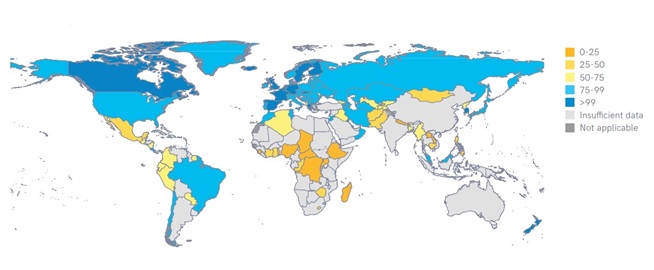NovaCast has been supporting global initiatives to improve access to clean water supplies since 2017, when we supported Xylem’s Watermark initiative. In 2018 we broadened our support by starting regular donations to the Planet Water Foundation, and 2020 we signed up to the WBCSD WASH Pledge for access to safe water and sanitation and hygiene (at the beginning of 2022, WBCSD transitioned the WASH Pledge resources and engagement to the WASH4WORK programme). If you follow each of these links, you will find further links to each of these initiatives.
As ever with worthwhile causes, the challenge is to raise awareness and tap into the underlying desire of people around the world to help others facing unimaginable challenges just to provide the basics of life for their families. You can find out more about how the WASH pledge operates and what it seeks to achieve here but we wanted to use this article to highlight some stark facts, which go some way to explaining just how important it is to actively support the individuals and organisations that are trying to make a difference:
“Global access to safe water, adequate sanitation, and proper hygiene education can reduce illness and death from disease, leading to improved health, poverty reduction, and socio-economic development. However, many countries are challenged to provide these basic needs to their populations, leaving people at risk for water, sanitation, and hygiene (WASH)-related diseases.”
The following facts were published in the United Nations Report: UN Water “Summary Progress Update 2021 — water and sanitation for all†July 2021.
- Drinking Water: 2 billion people (26% of the world’s population) lacked safely managed drinking water services in 2020. 771 million people still lacked even basic drinking water services. Among these, eight out of 10 lived in rural areas. Nearly half lived in least developed countries. The number of city inhabitants lacking safely managed drinking water has nearly doubled since 2000.
- Sanitation6 billion people (46% of the world’s population) lacked safely managed sanitation services in 2020 and 1.7 billion people still lacked even basic sanitation services. Among these, seven out of 10 lived in rural areas and four out of 10 lived in least developed countries.
- Hygiene: 2.3 billion people lacked a basic handwashing facility with soap and water at home in 2020.
- Wastewater: Globally, 44% of household wastewater is not treated safely.
- Water Quality: The lack of water quality data means that over 3 billion people are at significant risk because the health of their rivers, lakes and groundwater is unknown.
- Water Stress: 2.3 billion people live in water-stressed countries of which 733 million live in high and critically water-stressed countries.
- Ecosystems: 1/5 of the world’s river basins are experiencing rapid changes in the area covered by surface water.
- International Cooperation: Official Development Assistance (ODA) commitments to the water sector increased by 9% between 2015 and 2019 but actual disbursements showed little change.


Prevention
Finally, a few facts from the Centers for Disease Control and Prevention (CDC) in the US which highlight the opportunity to make a difference:
- Universal access to safe drinking water, adequate sanitation, and hygiene has the potential to reduce the global disease burden by 10%.1
- Increasing access to safe drinking water and sanitation services can prevent many diarrheal deaths. In 2016, unsafe drinking water and inadequate sanitation contributed to 829,000 deaths, equivalent to 60% of total diarrheal deaths.2
- Between 2000 and 2016, improved sanitation contributed to a 15% decrease in diarrheal deaths in Southeast Asia, East Asia, and Oceania, and more than a 10% decrease in diarrheal deaths globally.3
- Every cholera case and death from cholera is preventable with the tools we have today. Cholera prevention and control that integrates evidence-based best practices and identifies priorities could reduce cholera deaths by 90% by 2030.
- Investing in water and sanitation interventions results in many benefits, including economic, environmental, quality of life, and health. Every dollar invested in WASH interventions gives a $4.3 return in the form of reduced health care costs, reduced pollution of water and land resources, and gains in quality of life (such as improved school attendance, fewer sick days, greater privacy, safety, and sense of dignity).4
At NovaCast, we are actively involved in the Wash4Work programme and are committed to encouraging all who interact with our business, from employees to suppliers and customers, to support the initiative and spread awareness about its importance. As Richard Phillips, MD at NovaCast commented, “This is one of those situations where companies, through their extended supply chains, can really make a difference. We are fully behind the aims and ambitions of Wash4Work and encourage others to get involvedâ€.
References
- World Health Organization. Global costs and benefits of drinking water supply and sanitation interventions to reach the MDG target and universal coverage. Geneva: World Health Organization (WHO), 2012.
- A., Wolf, J., Bartram, J., Clasen, T., Cumming, O., Freeman, M. C., et al. (2019). Burden of disease from inadequate water, sanitation and hygiene for selected adverse health outcomes: An updated analysis with a focus on low- and middle-income countries.International journal of hygiene and environmental health, 222(5), 765-777.
- GBD 2016 Diarrhoeal Disease Collaborators (2018). Estimates of the global, regional, and national morbidity, mortality, and aetiologies of diarrhoea in 195 countries: a systematic analysis for the Global Burden of Disease Study 2016. The Lancet. Infectious diseases, 18(11), 1211-1228.
- World Health Organization and United Nations Water. Investing in water and sanitation: Increasing access, reducing inequalities.Geneva: World Health Organization (WHO), 2014.